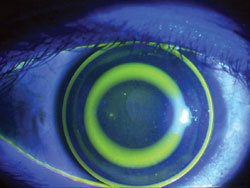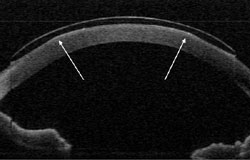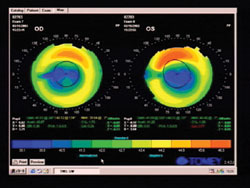Refraction, contrast sensitivity rebound after completion of orthokeratology
Major declines in optical quality from the reversible procedure included corneal irregular astigmatism and higher-order wavefront aberrations.
Orthokeratology proved reversible in a study, with refraction and visual acuity returning to baseline levels 1 week after the treatment was completed.
 Takahiro Hiraoka |
The study was the first to show the effects of orthokeratology to be reversible after 1 year of treatment, Takahiro Hiraoka, MD, PhD, said in an e-mail interview with Ocular Surgery News.
“The most important finding of our study is that the effect of orthokeratology is completely reversible in light of optical quality of the eye and quality of vision, as well as refraction and visual acuity,” Dr. Hiraoka said.
Orthokeratology is a nonsurgical procedure in which hard contact lenses worn during sleep reduce refractive error and improve visual quality, particularly in low to moderately myopic patients who desire independence from glasses or contact lenses. The procedure is considered a viable alternative to LASIK and PRK, the study authors said in the British Journal of Ophthalmology.
Indications for orthokeratology include low myopia of up to –4 D without astigmatism. Contraindications include keratoconus, corneal disease and severe dry eye. However, orthokeratology may be performed in the presence of mild dry eye, Dr. Hiraoka said.
 Corneal topography shows decentered treatment during orthokeratology treatment for myopia. |
 The anterior segment after fluorescein staining during orthokeratology. |
 Anterior segment optical coherence tomography imaging during orthokeratology. Arrows point to the space between the hard contact lens and cornea, called the tear reservoir zone. |
 Corneal topography after successful orthokeratology confirms a flatter central zone. Images: Hiraoka T |
Assessment and treatment
The prospective study included 46 eyes of 23 patients. Inclusion criteria were manifest spherical equivalent refraction between –4 D and –1 D, refractive astigmatism up to 1 D, best corrected visual acuity of 20/20 or better, mean keratometry between 40 D and 46.25 D, no previous orthokeratology and subjects 20 to 37 years old.
Patients with ocular or corneal pathology, history of ocular disease or previous ocular surgery and systemic diseases such as diabetes mellitus were excluded. Orthokeratology was conducted with four-zone reverse geometry contact lenses (Polymer Technology). Patients were directed to wear the lenses for at least 7 hours nightly for 12 months.
Refraction, corneal topography, wavefront aberrometry, visual acuity and area under the log contrast sensitivity function were assessed at baseline, 12 months after the start of treatment, and 1 week and 1 month after the completion of treatment.
Six patients discontinued treatment before 12 months, leaving a final study group of 34 eyes of 17 patients that completed 1-year follow-up.
Transient effects of orthokeratology
Study data showed that orthokeratology reduced manifest spherical equivalent refraction from –2.17 D at baseline to –0.17 D at 12 months and improved logMAR uncorrected visual acuity from 0.72 to –0.06. Both increases were statistically significant (P < .0001). BCVA and regular astigmatism did not change significantly, the authors said.
However, orthokeratology significantly increased corneal irregular astigmatism and higher-order aberrations and reduced area under the log contrast sensitivity function.
“Increases in corneal irregular astigmatism are quite similar to those in higher-order wavefront aberrations,” Dr. Hiraoka said. “Both parameters mean the decreases in optical quality of the eye. On the other hand, reduced low-contrast visual acuity implies the decline in quality of vision. Therefore, the main declines in optical quality caused by orthokeratology are corneal irregular astigmatism or higher-order wavefront aberrations.”
All visual and refractive parameters rapidly returned to pretreatment values after discontinuation of orthokeratology. Corneal irregular astigmatism, higher-order aberrations and contrast sensitivity function returned to baseline levels within 1 week after the end of treatment.
“As for the reason why corneal irregular astigmatism, [higher-order aberrations] and contrast sensitivity recovered more quickly than refractive error and UCVA, we at present have no clear explanation,” Dr. Hiraoka said. “But corneal surface contour is considered to recover rapidly after discontinuation of orthokeratology, as the early recovery of corneal thickness and curvature was confirmed. Thus, corneal irregular astigmatism, which reflects subtle changes in corneal surface shape, may have recovered quickly.”
The findings may prove useful in counseling patients considering LASIK or PRK, the authors said.
“On the basis of these findings, we can explain to patients that overnight orthokeratology is a reversible procedure,” they said. “In addition, the current information concerning each recovery time is quite useful to consider the starting point of the following procedure, if patients undergoing orthokeratology hope for another corrective option, such as laser refractive surgery.”
More research on the recovery of clinical parameters after cessation of orthokeratology in younger patients is warranted, the authors said. – by Matt Hasson
Reference:
- Hiraoka T, Okamoto C, Ishii Y, Okamoto F, Oshika T. Recovery of corneal irregular astigmatism, ocular higher-order aberrations, and contrast sensitivity after discontinuation of overnight orthokeratology. Br J Ophthalmol. 2009;93(2):203-208.

- Takahiro Hiraoka, MD, PhD, can be reached at Department of Ophthalmology, Institute of Clinical Medicine, University of Tsukuba, 1-1-1 Tennoudai, Tsukuba, Ibaraki 305-8575, Japan; +81-29-853-3148; e-mail: thiraoka@md.tsukuba.ac.jp. Dr. Hiraoka has no direct financial interest in the products discussed in this article, nor is he a paid consultant for any companies mentioned.
